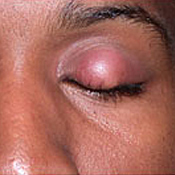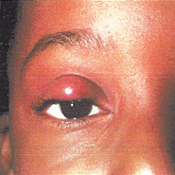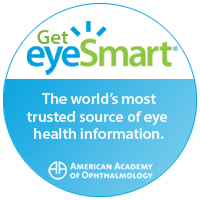
A stye often appears as a red, sore lump near the edge of the eyelid. A stye is usually caused by a bacterial infection. If the eyelash follicle is infected, a stye will develop at the base of the eyelash. A stye can also develop if there is an infection in one of the tiny lubricating oil glands inside or under the eyelid. If there is widespread inflammation of the eyelid from blepharitis, a stye may develop.
CHALAZION
A chalazion is an enlargement of an oil-producing gland in the eyelid called the meibomian gland. It forms when the gland opening becomes clogged with oil secretions. It not caused by a bacterial infection, and it is not cancerous. If an internal stye does not drain and heal, it can turn into a chalazion. A chalazion is usually painless, unlike a stye.
THE DIFFERENCE BETWEEN A CHALAZION AND A STYE
A chalazion can sometimes be confused with a stye which both appear as a lump on the eyelid. A stye is a red is a red, sore lump near the edge of the eyelid caused by an infected eyelash follicle. Chalazia tend to develop farther from the edge of the eyelid than styes.
SYMPTOMS OF STYE AND CHALAZION
At first, symptoms of a stye usually include eyelid tenderness and redness in the affected area with irritation and scratchiness in the eye. Further symptoms of a stye include:

A chalazion is an enlargement
of an oil-producing gland
in the eyelid.
- A red bump along the edge of the eyelid at the base of the eyelashes, usually with a small pus spot in the center.
- Feeling as if something is in the eye
- Light sensitivity
- Crusting along the eyelid margin
- Tearing
Many times there are n o symptoms associated with a chalazion. However, sometimes a chalazion may become red, swollen and tender. A large chalazion may also cause blurred vision by distorting the shape of the eye. Occasionally, a chalazion can cause the entire eyelid to suddenly swell.
TREATMENT FOR STYES AND CHALAZIA
Do not ever squeeze or try to pop a stye or a chalazion. Doing so may spread the infection into the surrounding eyelid tissue. Symptoms of a stye or chalazion are treated with one or more of the following methods:
- Warm Compresses. Warm compresses help to clear the clogged gland. Soak a clean washcloth on hot water and apply the cloth to the lid for 10 to 15 minutes three to five times a day until the stye or chalazion is gone. Repeatedly soak the cloth in the hot water to keep it warm. Using the warm compress should allow the clogged gland to open and drain white or yellow discharge. If the gland opens, gently massage around the stye, or chalazion, to help it drain.
- Antibiotic ointments. An antibiotic ointment may be prescribed if bacteria infect the chalazion or stye.
- Steroid injections. A steroid injection is sometimes used to reduce inflammation of a chalazion.
- Surgical removal. If a large stye or chalazion does not respond to other treatments , or affects your vision, your ophthalmologist may drain it surgically.
Chalazia and styes usually respond well to treatment, although on some people, they may recur. If a chalazion comes back in the same place, your ophthalmologist may suggest a biopsy to rule out more serious problems.
Do not wear eye makeup pr contact lenses until after the stye or chalazion heals.
WHO IS AT RISK FOR DEVELOPING STYES OR CHALAZIA?
Anyone can develop a stye or chalazion , but for those with blepharitis, you may be more likely to get either one.
You may also have an increased risk if you:
- Have had chalazia or stys previously
- Have skin conditions such as acne rosacea or seborrheic dermatitis
- Have other systemic medical conditions, such as diabetes
Lauderdale Eye Specialists provides this on-line information for educational purposes only and it should not be construed as personal medical advice. Lauderdale Eye Specialists disclaims any & all liability for injury or other damages that could result from use of the information obtained from this site.


